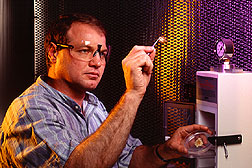Cah Marker Gene Aids Plant Transformations
|
|
Scientists aiming to genetically engineer crop plants are always on the lookout for genes they can use as markers in their experiments. Now, a gene known as cah may prove a useful addition to today's limited array of choices. That's according to Agricultural Research Service geneticist J. Troy Weeks at Lincoln, Nebraska.
Weeks and other biotechnologists pair a marker with an experimental gene intended to give a plant some prized trait, such as increased resistance to its worst insect or disease enemies.
The marker clearly flags, for researchers, plant cells that have the new, useful gene. Other plant tissue can then be discarded so scientists can focus their efforts on the potentially useful tissue. They nurture it into laboratory plantlets and later into greenhouse plants.
The marker gene that Weeks and colleagues are testing enables plants to tolerate a chemical called cyanamide. This versatile compound has some seemingly contradictory uses. It is an environmentally friendly fertilizer that, in specific situations, can also act as a herbicide or fungicide.
Weeks' laboratory use of cyanamide exploits the first two of these uses. His cah marker gene enables callus--clumps of plant tissue-- grown in petri dishes to convert cyanamide into urea fertilizer. Normally, plants cannot do this.
In petri dishes, cah-equipped cells soon appear as greenish sections against the yellow-white callus tissue. In later stages, this callus may develop healthy shoots and roots. Cells not containing the cah gene may appear brownish. The few short roots that may develop from this tissue usually won't survive. But the cah-containing cells, nourished by the cyanamide fertilizer, will thrive.
In addition to these readily apparent differences in callus, scientists can check for the cah gene with a fast, simple, and inexpensive assay. Unlike tests used to detect some other marker genes, the assay for cah does not require hazardous chemicals.
Where It's From, What It Does
The cah gene comes from a fungus found naturally in soils. Weeks saw the gene's biotech potential because he knew two things: The fungi--because of this gene--play an essential role in converting cyanamide into a useful fertilizer for plants; and without the fungi, cyanamide may kill plants instead of feeding them.
When used as a fertilizer, cyanamide must be applied before plants emerge. Soil microorganisms break it down into urea that plants can use. The microorganisms that do this job include the fungus Myrothecium verrucaria. The cah gene was borrowed from the fungus.
The gene cues the fungus--or in this case, the genetically engineered plant cells containing the cah gene--to create an enzyme called cyanamide hydratase. The enzyme enables the fungus or cah-equipped plant cell to add the water molecule necessary to convert the fertilizer form of cyanamide, called calcium cyanamide, into urea. Normally, if the calcium cyanamide fertilizer were mistakenly applied to plants, they might turn yellow and die--or at least produce lower yields.
In the laboratory, Weeks moved the cah gene into wheat cells using a bioblaster, or gene gun. The gun shoots microscopic gold particles--coated with experimental genes--into plant tissue in petri dishes. Then he grew the cells on a gelatinous bed of nutrients spiked with cyanamide.
Cells with the cah gene working inside could then convert cyanamide into urea fertilizer and grow shoots and roots that were the start of new plants. So far, Weeks has produced more than 100 healthy wheat plants with the cah gene inside. He is seeking a patent for his work.
Weeks collaborated with Olin D. Anderson of the ARS Western Regional Research Center in Albany, California; Kelly Y. Koshiyama of the University of California at Berkeley; Tony Schäeffner of Ludwig-Maximilians University in Munich; and Ursula Maier-Greiner, formerly at the Munich university. Maier-Greiner was part of a German team that was the first to discover and copy the cah gene.
The gene is a potential alternative to marker genes based on resistance to antibiotic drugs or to widely used commercial herbicides.
In lab experiments using an antibiotic-resistance marker, plant cells exposed to the antibiotic kanamycin--for example--won't thrive unless they take up this marker. Some critics fear that when people eat foods derived from such plants, their intestinal microflora might become resistant to the pharmaceutical. Biotechnologists see that as highly unlikely.
Marker genes that rely on resistance to widely used commercial herbicides have also drawn criticism, in part because of concern that the herbicide-resistance trait might escape if crop plants were to breed with weedy relatives nearby, perhaps creating super-resistant weeds. Because calcium cyanamide is not widely used as a herbicide, Weeks sees this risk as nil.
A Benign Alternative?
In new experiments, Weeks wants to determine if outfitting plants with the cah gene would open the door for growers to use calcium cyanamide fertilizer more conveniently; that is, not just on bare soil, but also when plants emerge--or perhaps anytime thereafter--without harming the plants.
"Cyanamide fertilizer apparently poses less risk of nitrate pollution to groundwater than do the popular urea-based or ammonium-nitrate-based fertilizers," Weeks says. Also known as lime nitrogen, calcium cyanamide fertilizer dates back to the early 1900s. It's made from heating lime and coal.--By Marcia Wood, Agricultural Research Service Information Staff.
For more information on U.S. patent application number 08/873,001, "Transformation of Wheat with the Cyanamide Hydratase Gene," contact J. Troy Weeks, USDA-ARS Wheat, Sorghum, and Forage Research Unit, 344 Keim Hall, University of Nebraska, Lincoln, NE 68583; phone (402) 472-9640, fax (402) 472-4020.
"Cah Marker Gene Aids Plant Transformations" was published in the July 1998 issue of Agricultural Research magazine. Click here to see this issue's table of contents.







